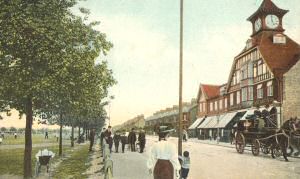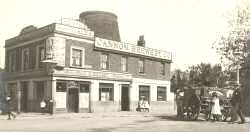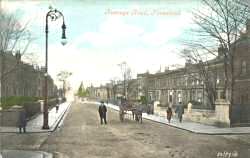Contents
- Before Development: A Place of Little Consequence
- Burrage Town: The First Estate in Plumstead
- Herbert Estate: Development on the High Slopes of Shooters Hill
- Plumstead Park Estate and the Saving of Plumstead Common
- The Plumstead Common Riots, 1876
- Bostall Estate, Abbey Wood
- Suburban Necessities: Churches, Schools, Shops and Public Houses
Plumstead: A 19th suburb of Woolwich's industrial and military might
by Barbara Ludlow
Burrage Town: The First Estate in Plumstead
The population of Plumstead at the beginning of the 19th century numbered 1,166, most of whom lived in or close to the village. St. Nicholas Church stood between the Manor Farmhouse, originally built as the vicarage, and the ancient tithe barn.
Close by in Plumstead High Street stood a large roadside public house called the Plume of Feathers. By 1800 some buildings straggled along the High Street and Plumstead Road towards Woolwich. The vast marshlands housed only a few smallholders and, similarly, the area around Plumstead Common was sparsely inhabited.
Three buildings of local significance stood on the common in 1800. At Winns Common to the east was the 18th century parish workhouse. The Pattison family, owners of Burrage House and a significant part of Plumstead, took young girls from the workhouse to labour in their silk mills at Congleton in Cheshire. Pauper apprentices came very cheap! After the passing of the New Poor Law Act in 1834 parish workhouses were scrapped and the poor of Plumstead had to go to the new Lewisham Union Workhouse.
Far less grim was the windmill on Plumstead Common, which had been built in 1764. The mill was still in great demand in at the beginning of the 19th century but much was about to change. As the century progressed the owners of Plumstead Common, Queens College, Oxford, began to draw up plans for enclosing and developing the common. This would have deprived the people of Plumstead access to the land over which they felt that they had inalienable rights. By the time that this argument came to a head the mill had ceased grinding corn and become a beerhouse.
Not far from the mill was Bramblebury House, an attractive building of 1793, which later became the vicarage to St. Margaret’s Church built on the common in 1859.
On the Woolwich side of Plumstead Common brick and tile makers had established works using local clay, chalk and brickearth. There were government contracts to be had as the military established themselves on Woolwich Common and new factories were needed in the Royal Arsenal.
In acreage Woolwich was a much smaller parish than Plumstead, and by the 1840s, the mass building of houses, which had begun with the sale of the Powis Estate in Woolwich in about 1798, was well underway.
The riverside was taken up with older structures and the Royal Naval Dockyard. In the mid-19th century the dockyard, the Arsenal, and other military establishments were still expanding. The part of Plumstead that adjoined Woolwich therefore became the logical place to build houses for workers in the government factories. In the early 1840s the Pattison family sold their Burrage Estate land in West Plumstead to the British Land Company.
The population of Plumstead in 1841 was 2,816; by 1851 it had risen to 8,373. Sandy Hill Road marks the spot where the first Burrage Town houses were built.
Very soon after Burrage Road was laid out from Plumstead Road to Plumstead Common Road. Plumstead Common Road roughly followed the track of an old lane, which led from Woolwich Common to Winns Common and Kings Highway.
Buildings soon lined the southern side of Plumstead Road but the marsh and opposite was earmarked for the royal Arsenal. The houses that gradually appeared in Plumstead Common Road were built for relatively prosperous families.
New roads were built between the major streets. A good example is Crescent Road whose attractive terraces linked Sandy Hill Road with Burrage Road. Lesser roads containing smaller houses intertwined between these developments.
Burrage town spread eastwards with Raglan Road crossing Burrage Road and linking east with west. Maxey Road, Pattison Road, and Vicarage Road bordered the first stage of development on the lower slopes of Plumstead, which dated from the mid 1840s to the 1860s. The grid pattern of streets in eastern Plumstead would be in sharp contrast to the higgledy-piggledy Burrage town, which had small twisty streets in between wide, straight roads.



